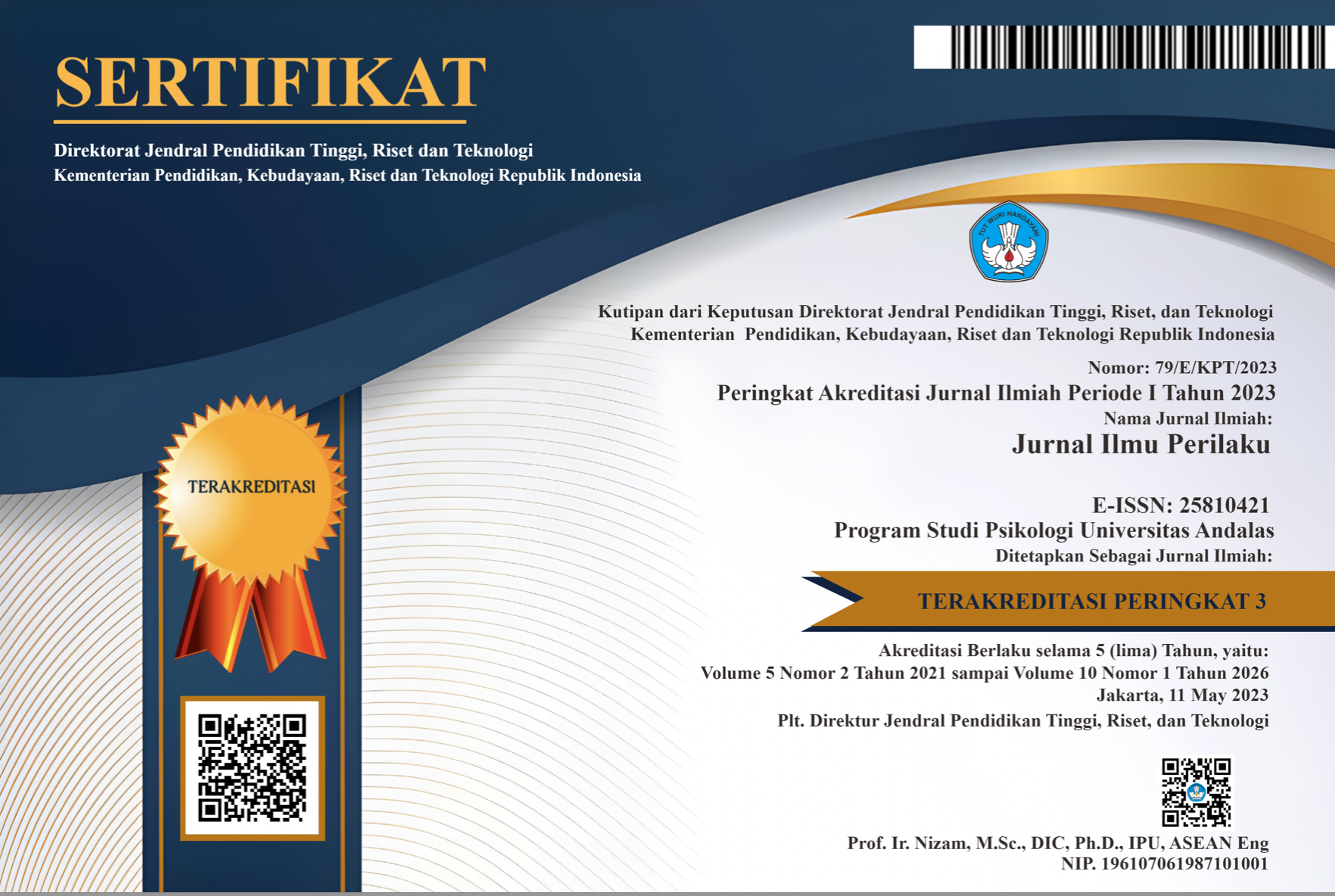Peran Kualitas Kelekatan Anak dengan Orangtua pada Keterampilan Sosial Remaja
Abstract
This research aimed to examine correlation between child-parent attachement and social skills in adolescent. Social skill is one of important parts in adolescent development, because adolescents are trying to build relationship beyond the family. One of the factors affecting social skills development among adolescent is the quality of attachment between child and parent. Hypothesis in this research stated that there is a correlation between child-parent attachment and adolescent’s social skills. Participants in this research were 164 high school students in Denpasar. Instruments used in this research were Social Skills Scale (α = 0,831) and Indonesian translated version of Inventory of Parent and Peer Attachment (α = 0,941). The Result of this study showed positive correlation between the quality of child-parent attachment and adolescent’s social skills (r=0,323, p<0,05). This result reflected the significant effort to improve the quality of attachment between child and parents in adolescence, with the result that adolescent will build good social skills.
Downloads
References
Bandy, T., & Moore, K.A. (2011). What works for promoting and enhancing positive social skills: Lessons from experimental evaluations of programs and interventions. Trends: Child Fact Sheet.
Beidel, D.C., Alfano, C.A., Kofler, M.J., Rao, P.A., Scharfstein, L., & Sarver, N.W. (2014). The impact of social skills training for social anxiety disorder: A randomized controlled trial. Journal of Anxiety Disorder, 28, 908-918.
Bowlby, J. (1969). Attachment and loss, Vol I: Attachment. New York: Basic Books.
Carr, S. (2009). Adolescent-parent attachment characteristics and quality of sport youth friendship. Psychology of Sport and Exercise 10, 653-661, doi: doi:10.1016/j.psychsport.2009.04.001
Cavendish, W., Nielsen, A.L., & Montague, M. (2012). Parent attachment, school commitment, and problem behavior trajectories of diverse adolescents. Journal of Adolescence 35, 1629-1639, diunduh dari: http://dx.doi.org/10.1016/j.adolescence.2012.08.001
Chow, C.M., Hart, E., Ellis, L., & Tan, C.C. (2017). Interdependence of attachment styles and relationship quality in parent-adolescent dyads. Journal of Adolescences 61, 77-86, diunduh dari: http://dx.doi.org/10.1016/j.adolescence.2017.09.009
Cobb, N.J. (2007). Adolescence continuity, change, and diversity (6th ed.). Boston: McGraw-Hill.
Colin, V.L. (1996). Human attachment. New York: McGraw-Hill.
Cyr, C., & Alink, L.R.A. (2017). Child maltreatment: The central roles of parenting capacities and attachment. Current Opinion in Psychology 2017, 15, 81-86, diunduh dari: https://doi.org/10.1016/j.copsyc.2017.02.002.
Dereli, E., & Karakus, O. (2011). An examination of attachment styles and social skills of university students. Electronic Journal of Research in Educational Psychology 9(2), 731-744.
Elksnin, L.K., & Elksnin, N. (1997). Issue in the assessment of children’s social skills. Diagnostique 22(2), 75-86, diunduh dari aei.sagepub.com.
Flaherty, S.C., & Sadler, L.S. (2010). A review of attachment theory in context of adolescent parenting. Article by National Association of Pediatric Nurse Practitioners .
Gillath, O., Karantzas, G.C., & Lee, J. (2018). Attachment and social networks. Current Opinion in Psychology 2018, 25, 21-25, diunduh dari: https://doi.org/10.1016/j.copsyc.2018.02.010
Hair, E.C., Jager, J., & Garret, S. (2002). Helping teens develop health social skills and relationships: What the research shows about navigating adolescence. Trends Child Research. Diunduh dari http://www.childtrends.org/PDF/KnightReports/KSocial.p pada 30 Januari 2015.
He, J., Chen, X., Fan, X., Cai, Z., & Hao, S. (2018). Profiles of parent and peer attachment of adolescents and associations with psychological outcomes. Children and Youth Service Review 94, 163-172, doi: https://doi.org/10.1016/j.childyouth.2018.10.001.
Husni, M.A., & Purwaningsih, I.E. (2013). Identitias diri ditinjau dari kelekatan remaja pada orang tua di SMKN 4 Yogyakarta. Jurnal SPIRITS 3 (2), 1-92.
Natalia, C. (2014). Hubungan antara kelekatan aman pada orangtua dengan kematangan emosi remaja akhir di Denpasar (Skripsi tidak dipublikasikan). Universitas Udayana, Denpasar.
Nikooyeh, E., Zarani, F., F& athabadi, J. (2017). The mediating role of social skills and sensation seeking in the relationship between trait emotional intelligence and school adjustment in adolescents. Journal of Adolescence 59, 45-50, diunduh dari: http://dx.doi.org/10.1016/j.adolescence.2017.05.012.
Octama, R., Hasyim, A., & Adha, M.M. (2013). Pengaruh ekstrakurikuler palang merah remaja (PMR) terhadap sikap sosial siswa SMA. Jurnal Kultur Demokrasi, 1 (6), 2-14.
Oldmeadow, J.A., Quinn, S., & Kowert, R. (2013). Attachment style, social skills, and Facebook use amongst adults. Computers in Human Behavior 29, 1142-1149, diunduh dari: http://dx.doi.org/10.1016/j.chb.2012.10.006.
Patrick, N.J. (2008). A practical guide to day-to-day life: Social skills for teenagers and adults with asperger syndrome. London: Jessica Kingsley Publishers.
Peraturan Menteri Nomor 81 tahun 2013 tentang Pendirian Satuan Pendidikan Non Formal. Jakarta: Kementerian Pendidikan dan Kebudayaan.
Praptomojati, A. (2017). Dinamika psikologis remaja korban perceraian: Sebuah studi kasus kenakalan remaja. Jurnal Ilmu Perilaku 2 (1), 1-14, diunduh dari
http://jip.fk.unand.ac.id/index.php/jip/article/view/53/24.
Rice, F.P. & Dolgin, K.G. (2002). The Adolescent: Development, Relationships, and Culture (10th ed.). Boston: Allyn and Bacon.
Salavera, C., Usan, P., & Jarie, L. (2017). Emotional intelligence and social skills on self-efficacy in secondary education students. Are there gender differences? Journal of Adolescences 60, 39-46, diunduh dari: http://dx.doi.org/10.1016/j.adolescence.2017.07.009.
Santrock, J.W. (2011). Life-Span Development (13th ed.). New York: McGraw-Hill.
Spence, S.H. (2003). Social skills training with children and young people: theory, evidence, and practice. Child and Adolescent Mental Health 8, 84-96.
Stravynski, A., Kyparissis, A., & Amado, D. (2014). Chapter 8 – Social phobia as deficit in social skills. Book review: 3rd edition of social anxiety pages 189-225.
Su, S., Pettit, G.S., & Erath, S.A. (2016). Peer relations, parental social coaching, and young adolescent social anxiety. Journal of Applied Developmental Psychology 42, 89-97, diunduh dari: http://dx.doi.org/10.1016/j.appdev.2015.11.007
Sugarman, L. (2005). Life-span development frameworks, accounts, and strategies (2nd ed.). New York: Psychology Press: Taylor & Francis Group.
Verawati, I. (2011). Popularitas pada remaja ditinjau dari konsep diri dan keterampilan sosial (Tesis tidak dipublikasikan). Universitas Gadjah Mada, Yogyakarta.
Vugt, E.S.V., Dekovic, M., Prinzie, P., Stams, G.J.J.M., & Asscher, J.J. (2013). Evaluation of a groub-based social skills training for children with problem behavior. Children and Youth Service Review 35, 162-167.
The non-commercial use of the article is governed by the Creative Commons Attribution license as currently displayed on Creative Commons Attribution-NonCommercial-ShareAlike 4.0 International License.
JIP's spirit is to disseminate articles published are as free as possible. Under the Creative Commons license, JIP permits users to copy, distribute, display, and perform the work for non-commercial purposes only. Users will also need to attribute authors and JIP on distributing works in the journal.
Please find the rights and licenses in Jurnal Ilmu Perilaku (JIP).
- License
The non-commercial use of the article will be governed by the Creative Commons Attribution license as currently displayed on Creative Commons Attribution-NonCommercial-ShareAlike 4.0 International License.
- Author’s Warranties
The author warrants that the article is original, written by stated author(s), has not been published before, contains no unlawful statements, does not infringe the rights of others, is subject to copyright that is vested exclusively in the author and free of any third party rights, and that any necessary written permissions to quote from other sources have been obtained by the author(s).
- User Rights
JIP's spirit is to disseminate articles published are as free as possible. Under the Creative Commons license, JIP permits users to copy, distribute, display, and perform the work for non-commercial purposes only. Users will also need to attribute authors and JIP on distributing works in the journal.
- Rights of Authors
Authors retain the following rights:
- Copyright, and other proprietary rights relating to the article, such as patent rights,
- The right to use the substance of the article in future own works, including lectures and books,
- The right to reproduce the article for own purposes, provided the copies are not offered for sale,
- The right to self-archive the article.
- Co-Authorship
If the article was jointly prepared by other authors, the signatory of this form warrants that he/she has been authorized by all co-authors to sign this agreement on their behalf, and agrees to inform his/her co-authors of the terms of this agreement.
- Termination
This agreement can be terminated by the author or JIP upon two months’ notice where the other party has materially breached this agreement and failed to remedy such breach within a month of being given the terminating party’s notice requesting such breach to be remedied. No breach or violation of this agreement will cause this agreement or any license granted in it to terminate automatically or affect the definition of JIP.
- Royalties
This agreement entitles the author to no royalties or other fees. To such extent as legally permissible, the author waives his or her right to collect royalties relative to the article in respect of any use of the article by JIP or its sublicensee.
- Miscellaneous
JIP will publish the article (or have it published) in the journal if the article’s editorial process is successfully completed and JIP or its sublicensee has become obligated to have the article published. JIP may conform the article to a style of punctuation, spelling, capitalization, referencing and usage that it deems appropriate. The author acknowledges that the article may be published so that it will be publicly accessible and such access will be free of charge for the readers.










